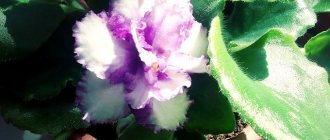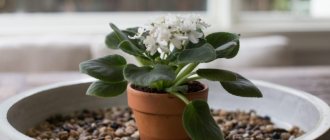One day, in the Uzambara Mountains, Baron Saint-Paul Iller discovered a lovely plant with velvety leaves, strewn with bright flowers. This is how one of nature’s favorite and popular creations appeared to the world - Saintpaulia, Usambara violet or indoor violet. All these are names of the same plant, which is valued for the beauty of its leaves, flowers and duration of flowering. They also love it because the small size of the pots with violets easily fits on narrow window sills and allows them to decorate any room.
Features of Saintpaulia violet
Saintpaulia ionantha, or Uzambara violet, is registered in the Gesneriev family. Homeland - East Africa.
Despite its fragility and tenderness, home violet is resistant to external irritants and adverse conditions. Lack of care is not a problem for them if vital conditions are provided.
The description of the violet lists all its main features:
- low-growing herbaceous plant;
- the stem is shortened;
- the rosette looks like a nest with numerous long-petioled leaves;
- medium-sized flowers, from 3 to 7 on one peduncle;
- flowers are simple, semi-double and double, petals are found both regular and corrugated;
- at the peak of flowering there can be up to 80-100 flowers on one plant;
- The flowering duration of most species is 8-9 months; for some - almost the whole year;
- More than 1,500 varieties of plants have been bred, differing in size, shape, color of leaves and flowers;
- All varieties are descended from Saintpaulia violetflower.
The discoverer of violets was Baron Walter von Saint-Paul. He found blue flowers resembling forest violets in the forests of East Africa at the foot of the Uzambara Mountains.
Even before the discovery of violets by Saint-Paul, legends were formed about them. One talks about Adam's tears turning into Saintpaulia. Another tells how the formidable Zeus turned a nymph who was running away from Apollo into a fragile flower.
When breeders got down to business, a huge variety of hybrids and varieties appeared. Now work is underway to ensure that the plants have a pleasant aroma. Although Saintpaulia has been growing for several decades with pink flowers and a slight smell of black pepper.
It is interesting to get acquainted with the richness of colors of other representatives of the Gesnerievs:
- gloxinia;
- streptocarpus;
- koleria.
How to care for violets at home
Fans of indoor floriculture are passionate about creating beautiful compositions. Saintpaulia is the main one in them. They know almost everything about violets. But for novice gardeners it is necessary to know the rules of care and maintenance of this plant.
Caring for violets is not at all difficult. By following all the rules, you can have a year-round flowering plant on your windowsill. There are few important conditions that this plant needs. You need to pay attention to them and ensure comfortable development of the violet.
Temperature
Violets do not have a specific time when they are at rest. The same temperature throughout the year is an important condition for their successful cultivation.
The air temperature should be 18 – 20°C all year round. In winter they tolerate 16°C. If the temperature is reduced to 15 degrees or, conversely, rises to 30, the Saintpaulia flower will begin to fade, stop blooming and stop growing.
Violets do not tolerate drafts. They cannot be placed on an unglazed balcony or taken out into the garden. Temperature changes are unacceptable; violets will not develop and bloom if they are either hot or cold.
But if the ambient temperature in the room is always low (or high), and you want to grow violets, then there is a proven method:
- find healthy leaves on plants;
- grow new flowers from them;
- maintain the same temperature.
Given the plasticity of Saintpaulia, the next violets grown will be ready for the conditions around them.
Lighting
Violets grow well on the windowsills of western, eastern and northern windows. Saintpaulias should be provided with bright but diffused light at all times.
If it is not possible to illuminate the flowers uninterruptedly, then a minimum 12-hour light regime for them must be organized in any season of the year.
At midday, be sure to shade from direct sunlight. Blinds, thick curtains and curtains are reliable protection for Saintpaulia.
If there is not enough daylight, then gardeners use various modifications of lighting. They are especially relevant in heavily shaded places: corridors, living rooms, office spaces.
In order for the flower bushes to look attractive and compact (and not one-sided), their shadow sides must be periodically turned towards the light.
Watering violets
Patient in all respects, the violet is demanding when it comes to watering. Both the amount of water and the way it reaches the flower are important.
Watering should be done moderately. Do not allow water to get on flowers, leaves or in the middle of the rosette. Drops should not fall on the leaves, otherwise spots, circles or rot will appear on them. The plant will die.
How common watering methods are used in caring for Saintpaulia:
- Watering from below. Water is poured into a pan, from which it gradually begins to be absorbed into the ground. Give time for the soil ball to get wet all the way to the surface. The plant itself absorbs the amount of moisture it needs. The main thing is to drain the remaining water in the pan by evening. This will help prevent root rot.
- Watering from above. Using a watering can with a narrow, long spout, direct the stream of water to the edge of the pot so as not to wet the neck of the root. Make sure that the stream of water does not wash away the soil in the pot. When the water is completely absorbed into the ground, you need to repeat the procedure. Continue until water seeps into the tray through the holes in the bottom of the pot. Approximately 1.5 hours after the end of watering, the water from the pan must be drained.
Water for irrigation should be at room temperature and allowed to stand for at least a day; it would not be a bad idea to let it sit for two to three days. The soil should dry out between waterings. Otherwise, fungus may form on the roots. The plant will die.
Spraying the flower should be avoided. In order to maintain the necessary humidity that indoor violets constantly need, the pots must be placed in trays filled with damp sphagnum or peat. Or on a tray with a cup.
How to water violets using the drip method
Given Saintpaulia's sensitivity to watering, it is beneficial to implement hydroponic growing methods. The drip method of irrigation has a beneficial effect on the development of plants. There are automatic drip systems for this, but it is quite possible to get by with a self-designed device.
You need to select containers (cut plastic bottles will also help) in which it is convenient to place pots with plants.
Drip - or wick - watering consists of pouring water into an external container, and pulling a plastic tube or synthetic cord from the pot through the drainage hole. They transport water to the roots exactly in the amount that the plant needs.
In addition to the normal supply of water, there are additional advantages to watering violets in the described way at home:
- Saintpaulias develop faster and bloom longer;
- You can add a nutrient solution to the water and thus feed the plants;
- you can go on vacation without worrying about your flowers;
- no need to ask someone to look after the plants and water them on time.
Feeding and fertilizer
During the period of intensive growth, healthy violets with a well-developed root system need nutrition to form green shoots and flowers.
These plants grow in the wild on rocky soil. The soil is depleted, with a minimum content of nutrients and microelements. However, the space where the plant's roots find nutrition is much larger than the volume of the pot. Therefore, at home, Saintpaulia requires additional care in the form of feeding.
Violets in pots need regular fertilization from late April. Ready-made mineral fertilizers for indoor plants with a minimum amount of nitrogen are suitable. They need to be applied twice a month. If you fertilize the violet frequently, it will react negatively. In winter, the flower is not fed with anything.
Useful supplements can be found in your own kitchen, without additional financial costs. These are additional, not basic, means:
- peels of oranges, lemons, tangerines infused with water;
- coffee grounds;
- yeast solution;
- sugar diluted in water;
- decoction of onion peels.
Dried tea leaves and water from meat, popular folk remedies, are not suitable for Saintpaulia. From them, leaf mosquitoes - sciarids - can settle on plants.
Read more in the article Feeding indoor flowers with home remedies.
In spring and summer, violets are fed every two weeks with mineral fertilizer with a complete composition for indoor crops. Can be purchased in small bags packaged for single use.
A convenient option for producing fertilizers in the form of sticks. In this case, you don’t have to worry about an overdose: you put a stick of fertilizer in the pot and you don’t have to think about fertilizing for 2 months. It is practical to use the preparations in liquid form along with watering.
Do not feed Saintpaulia in the following cases:
- if it is hot and very dry air;
- immediately after the transplant, at least a month must pass;
- if pests appear.
Be careful with dosages. Experienced flower growers advise taking 2 times less fertilizer than recommended in the instructions. Also, before fertilizing the flowers, they must first be watered with clean water.
Transplanting violets
At home, violets must be replanted if they were purchased in stores or supermarkets. There they are often overfed with fertilizers and oversaturated with moisture. If you bought flowers at markets from private flower growers, then at first it is better to do without replanting and let the root system grow. As soon as the entire earthen lump in the glass is intertwined with roots, then you can transplant the plant into a pot.
Violets are flowers that quickly generate daughter rosettes. Therefore, every potty pet will soon need a transplant.
Transplantation is provided in the following cases:
- if the plant has grown greatly;
- when the soil becomes acidic from excess moisture;
- if the flowers begin to hurt or are attacked by pests.
To plant violets correctly, you need to remember the seasonality. The most suitable time is cool summer, warm autumn and spring. Especially if the plants were exposed to additional lighting in winter. April and May are the most favorable months for transplantation.
If the plant begins to bloom, then replanting is permissible only in an emergency. And only by transshipment method.
Formation of a bush
Violets require periodic inspection of the above-ground parts. How to trim a violet so that the bushes look symmetrical:
- remove a leaf with an overgrown cutting using a very sharp sterile instrument - a knife or pruning shears;
- damaged or drying leaves can be removed manually;
- pinch the top of the main shoot.
The neat shape of the rosette is an additional decoration of the plant.
Rest period
Saintpaulia does not have a pronounced dormant period. This plant is perennial and evergreen. It does not lose its leaves even in winter, and violet flowers can appear all year round. But even here nature provided a short pause for plants.
Caring for violets at home in winter has its own characteristics. In winter, the plant needs more light (additional lighting). Monitor humidity and temperature carefully. Heating radiators dry out the air greatly. It is necessary to regularly humidify the air near the flower garden. Watering should be reduced.
It is useful to move flower pots to a dark place during the dormant period and reduce watering to a minimum. Violets will rest peacefully.
How to determine that a violet needs watering
There are differences in how to water a baby violet and an adult plant. Young shoots need constant soil moisture. And mature bushes are irrigated when the surface of the earth is completely dry.
Saintpaulias tolerate the drying out of the substrate more easily than its waterlogging. If the same soil composition was used in the pots, you can learn to determine by eye when to water the bushes and when to hold off on watering. If the soil is dark in color, then it has enough moisture. Light colored soil indicates a lack of fluid.
The weight of the pot can also determine the condition of the soil. Soil with enough moisture will be heavier. The weight can be checked by lifting the pots in your hands one at a time.
Watering frequency
How often to water violets depends on many factors:
- Illumination. As the length of daylight decreases, all processes in the plant are inhibited and the need for moisture decreases.
- Air temperature. The higher the temperature, the more often the irrigation procedure needs to be carried out.
- An indicator of humidity that varies depending on the time of year and the weather outside the window. It must be maintained at 50%.
- Plant age. Young shoots especially need frequent watering.
- Development of the Saintpaulia root system. If the roots completely entwined the soil in the pot, then such a substrate will dry faster.
- Presence of buds. Violet requires much more water during the period of active flowering.
- Dimensions and material for making the pot. In plastic containers, moisture lingers longer, but in clay containers it evaporates through the walls. A large pot contains enough soil to nourish the root system for a long time.
- Soil characteristics. Dense substrate does not dry well. Liquid evaporates faster from the surface of breathable soil.
Bloom
Violets are one of the beautiful flowering indoor flowers and are grown for their wonderful blooms.
Violets bloom profusely and grow well if you use ion exchange culture or hydroponics under artificial light. Sufficiently bright lighting regulates the active flowering phase. Saintpaulia will begin to produce many new flowers.
It should be remembered that plants quickly become depleted during endless flowering. They need 8 weeks of rest in a dark place.
Abundant flowering usually begins in the second year of violet growth and development.
How to care for violets after flowering
Proper care at home for the Uzambara violet after flowering is to replant it. Some tips on how to do this:
- break off all the lower leaves and dry flower stalks;
- remove the violet from the pot and separate the stepsons for rooting;
- trim the lower part of the root by 1.5 - 2 cm;
- if you intend to use the old pots, then wash them from salt deposits without detergents;
- fill half the container with soil and immerse the exposed rosette trunks into it as deeply as possible;
- add fresh soil on top of the pots without compacting them;
- Water a little, the soil will settle a little and you can add new soil.
The violet planted in this way should be placed in a place with gentle, shaded lighting. Water carefully and moderately - do not overwater, do not overdry.
Typically, caring for violets after flowering does not cause problems if you follow all the recommendations exactly.
Natural conditions
For successful cultivation, it is important to provide conditions close to the natural habitat.
The flower's homeland is hot Africa, but various varieties thrive on almost all continents. In nature, violets prefer open glades or slightly shaded areas with moderate humidity.
Saintpaulia habitats are characterized by twelve-hour daylight hours. The brightness of the southern sun is softened by high clouds. These flowers do not like direct sunlight, which disturbs the color of the leaves.
At home, flowers are placed on windows facing east. In warm climates, violets grow on the north or northeast side. Diffused light is used for lighting.
In winter and autumn, daylight hours in countries with temperate climates are significantly reduced. For normal flowering, Saintpaulias need artificial lighting.
Reproduction
At home, a productive method of propagating violets for further cultivation has been chosen by flower growers for a long time. It is simple and accessible. This is the propagation of Saintpaulia by leaves. You can propagate flowers all year round, but it is better in spring and summer.
How to grow violet from cuttings
For cuttings, select a fully developed Saintpaulia leaf with a 1 cm petiole. Place it in a container of water, peat-sand mixture or sand. The petiole will take root in a month. In two months, young leaves will appear.
When propagating by leaf cuttings, it may happen that the daughter plants do not inherit all the varietal qualities of the mother specimen. In order not to “lose” a beautiful violet, you need to root several leaves. For example, out of three young plants, only one or two will completely inherit the characteristics of a given variety.
Dividing bushes into rosettes
When growing violets, rosettes form on the plant bushes. They are also called children. Over time, the developing rosettes cause the flower to become very cramped in the pot. Saintpaulia may stop growing and not bloom. Exit in the following steps:
- remove a flower from a pot;
- carefully separate all rosette roots;
- Plant rosettes in separate pots.
If the plants are not sick, then they can be divided into rosettes during flowering.
Pests and diseases
When caring for violets at home, you must remember that in the event of a plant disease, it is advisable, if possible, to do without the use of pesticides. They are toxic and harmful not only to people, but also to flowers. Harmless herbal preparations act sparingly. Or a mechanical way to destroy pests - collecting by hand.
Diseases and their treatment
Fragile Saintpaulias are vulnerable to careless care. They may suffer from common diseases.
- Fusarium. The disease affects the leaf rosette, in which the petioles one after another become watery transparent and rot. The disease can be provoked by temperature changes and drafts, as well as watering with cold water. Immediate removal of the affected parts is required, followed by treatment of the rosette and rhizome with a fungicidal solution.
- Rust appears from the spread of fungus. Visual signs are yellow-brown raised spots on the surface of the leaves. It is obvious that the plant needs treatment. Affected leaves should be removed and the entire bush should be treated several times with fungicidal preparations.
- Powdery mildew most often appears on the leaves of Saintpaulia from insufficient lighting and excess humidity. In addition to treatment using a foundation solution, it is necessary to change the living conditions of the flower. Otherwise he won't be able to cope.
- Gray rot is an insidious disease that quickly spreads to the entire plant. It is caused by a complex of unfavorable factors - temperature changes, waterlogging of the soil, insufficient lighting. The leaves become moldy and die. It is extremely difficult to treat. More often than not, the affected plant must be destroyed.
To prevent diseases, daily inspection of indoor plants and watering with Fundazol solution is necessary once every two months. This is a well-proven drug for the prevention and treatment of fungal diseases.
Pests and their control
Saintpaulia violet can get sick and even die from pest attacks. The most common among them:
- aphid;
- all kinds of mites;
- worms that attack roots.
Proper care of violets and daily careful inspection will prevent pest invasion in time. It is recommended to use only herbal preparations for destruction - infusions of garlic and onions, red hot pepper, citrus peels, tomato leaves, tobacco, pyrethrum.
The transplant process - when and how to do it correctly?
Saintpaulias need to be replanted into new soil immediately after purchase and every year thereafter. If this is not done, the soil is depleted, the amount of nutrients in it decreases, and the flowers lose their healthy appearance. Without replanting, violets stop blooming after three years. The need for replanting can be judged by a white coating on the soil, which indicates that air is not passing into the soil. Replanting is also necessary if the roots are tightly intertwined and cover the entire lump of earth. This is one of the reasons why the plant stops blooming.
There can be any time of year for transplantation, but in spring the flowers tolerate the procedure more easily and recover faster. Flower growers do not recommend carrying out the procedure during flowering. But there are situations when this rule can be neglected, for example, when the soil becomes acidic or the flower is damaged by pests.
We transplant the violets into wet soil that does not stick to our hands. It is not recommended to use an old container. We take a pot larger than the previous one. It should be three times larger in diameter than the violet rosette. For example, for a rosette with a diameter of 28 cm, a container with a diameter of about 9–10 cm is suitable. If the pot is too spacious, the Saintpaulia will grow, but there will no longer be abundant flowering. It is better to use plastic rather than ceramic containers. The soil for replanting is loose, containing admixtures of peat and sand, which ensure air and water permeability of the soil.
We water the transplanted plant to wet the earthen ball. Thus, we reduce the likelihood of damaging the root system. At the bottom of the new flowerpot we pour drainage from expanded clay or sphagnum moss. We remove the flower from the old container, shake off the old soil, cut off the yellowed peduncles and leaves, remove the stepsons that appear in the axils of the leaves. If we leave the root trunk, then we bury it in the ground. You can cut off the trunk and place the remaining part of the plant in water until roots appear.
We plant the plant at such a depth that the lower leaves do not touch the ground. We fill the free space with soil mixture so that it settles better, and knock the pot on the table. Water only the next day. After a day, if necessary, add soil.
Some varieties do not require complete replacement of the soil; replanting with partial replacement is suitable for them. With such a transplant, the roots are not cleared of old soil, but are transplanted together with a clod of earth; this minimizes the risk of damage to them and ensures faster and more comfortable adaptation.
Types and varieties of violets
The painstaking work of breeders has so enriched the violet world that it was necessary to create several classifications dividing varieties into groups.
In the American classification, violets are described and systematized according to the following characteristics:
- socket size;
- by leaf type;
- their colors;
- by type of flower;
- by the color of the petals;
- by the number of petals.
This classification, very complex due to the huge number of varieties, is used by many gardeners.
Classification by socket size
The sizes of Saintpaulia rosettes range from miniature to large with a half-meter diameter:
- micromini (up to 6 cm);
- mini (from 10 to 15 cm);
- midi (from 15 to 20 cm);
- standard (from 20 to 40cm);
- large standard (from 40 to 50 cm).
A separate category is trailer violet, which has elongated stems.
Violets with micro rosette
Leaf color and edge line
Saintpaulia usually produces an environment of serrated or entire velvety leaves that are round, oval or ovoid in shape with a heart-shaped base.
The upper side of the leaves can have a color from light to dark green, the lower side is pale green or purple, with sharply protruding veins, the leaves are pubescent along the edges, depending on the variety.
Common problems and difficulties
Violet diseases - types and how to fight
- Gray rot. If its spots are detected on the stem and leaves, the diseased areas are cut off, the soil is replaced and is no longer used.
- Powdery mildew. Forms a white coating on the leaves. You can get rid of it using special products that can be purchased at gardening stores.
- Rust. Orange spots form on the green part of the plant. Treated with a 1% solution of copper sulfate.
- Furaziosis. It affects the petioles of the deciduous part. Occurs due to waterlogging. Eliminated by treatment with drugs.
- Late blight. When it occurs, the roots rot and brown spots appear on the foliage. The diseased violet is destroyed along with the pot.
- Mites - poutine and other varieties. Red specks and cobwebs form on the flower. Peduncles are cut off, bushes are treated with acaricides.
- Scale insects. They live on the underside of leaves and leave sticky marks. They are difficult to remove and only with the help of medications.
- Nemitods. The plant rots. It is completely destroyed.











